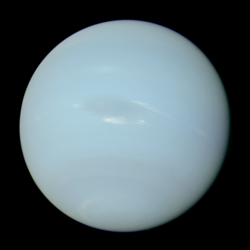Planets/Neptune
Neptune is the eighth and farthest known planet from the Sun in the Solar System.

Location
editSun | Mercury | Venus | Earth | Mars | Jupiter | Saturn | Uranus | Neptune
History
editNeptune is not visible to the unaided eye and is the only planet in the Solar System found by mathematical prediction rather than by empirical observation. Unexpected changes in the orbit of Uranus led Alexis Bouvard to deduce that its orbit was subject to gravitational perturbation by an unknown planet. The position of Neptune was subsequently calculated from Bouvard's observations, independently, by John Couch Adams and Urbain Le Verrier after his death. Neptune was subsequently observed with a telescope on 23 September 1846[1] by Johann Galle within a degree of the position predicted by Le Verrier. Its largest moon, Triton, was discovered shortly thereafter, though none of the planet's remaining 13 known moons were located telescopically until the 20th century. The planet's distance from Earth gives it a very small apparent size, making it challenging to study with Earth-based telescopes. Neptune was visited by Voyager 2, when it flew by the planet on 25 August 1989; Voyager 2 remains the only spacecraft to visit Neptune.[2][3]
Composition
editThe Scooter is another storm, a white cloud group farther south than the Great Dark Spot. Its nickname is due to the fact that when first detected in the months before the 1989 Voyager 2 encounter it moved faster than the Great Dark Spot.[4] Subsequent images revealed even faster clouds.
The Small Dark Spot is a southern cyclonic storm, the second-most-intense storm observed during the 1989 encounter. It initially was completely dark, but as Voyager 2 approached the planet, a bright core developed and can be seen in most of the highest-resolution images.[5]
The persistence of companion clouds shows that some former dark spots may continue to exist as cyclones even though they are no longer visible as a dark feature. Dark spots may dissipate when they migrate too close to the equator or possibly through some other unknown mechanism.[6]
References
edit- ↑ Hamilton, Calvin J. (4 August 2001). "Neptune". Views of the Solar System. Archived from the original on 15 July 2007. Retrieved 13 August 2007.
- ↑ Chang, Kenneth (18 October 2014). "Dark Spots in Our Knowledge of Neptune". New York Times. Archived from the original on 28 October 2014. Retrieved 21 October 2014.
- ↑ "Exploration | Neptune". NASA Solar System Exploration. Retrieved 2020-02-03.
In 1989, NASA's Voyager 2 became the first-and only-spacecraft to study Neptune up close.
{{cite web}}: CS1 maint: url-status (link) - ↑ Burgess (1991):64–70.
- ↑ Sue Lavoie (29 January 1996). PIA00064: Neptune's Dark Spot (D2) at High Resolution. NASA JPL. http://photojournal.jpl.nasa.gov/catalog/PIA00064. Retrieved 28 February 2008.
- ↑ Sromovsky, L. A.; Fry, P. M.; Dowling, T. E.; Baines, K. H. (2000). "The unusual dynamics of new dark spots on Neptune". Bulletin of the American Astronomical Society 32: 1005.